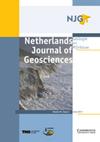Fracture characteristics of Lower Carboniferous carbonates in northern Belgium based on FMI log analyses
IF 2.3
2区 地球科学
Q3 GEOSCIENCES, MULTIDISCIPLINARY
Netherlands Journal of Geosciences-Geologie En Mijnbouw
Pub Date : 2020-06-19
DOI:10.1017/njg.2020.6
引用次数: 3
Abstract
Abstract Recently drilled geothermal boreholes in Mol, northern Belgium, provide new information on the Lower Carboniferous carbonates in the Campine–Brabant Basin. Because of low primary porosity, fractures in these limestones and dolostones are of major importance for reservoir permeability. The Fullbore Formation MicroImager (FMI) log of the MOL-GT-01 borehole enabled interpretation of bed boundaries and fractures in the subsurface. Relationships between the frequency of these fractures and bed thickness, lithology variations and the presence of faults were explored. The results show that thick beds contain relatively few fractures and thin beds relatively many. Except for lower values in shaly intervals, the fracture frequency (number per metre) is largely independent of lithology. Zones with substantial changes in the structural dip (called a cusp) and/or azimuth of bed boundaries were identified. The clearest cusp is present at a depth of 3284 m. Since the presence of a normal fault is most likely regarding the local and regional geology, this cusp likely resembles a fault-tip fold of a WSW-ward dipping normal fault with an inclination of at least 54°. It is uncertain whether the borehole crossed the fault itself or only a monocline on top of it. Fracture frequency is increased in the vicinity of the interpreted possible faults. Up to a vertical distance of c.45 m from the faults, the mean fracture frequency is higher than in a non-faulted zone with similar lithology. However, frequency differences between these faulted and non-faulted zones are mostly insignificant, so no clear damage zones are present.基于FMI测井分析的比利时北部下石炭统碳酸盐岩裂缝特征
最近在比利时北部Mol的地热钻孔为Campine-Brabant盆地下石炭统碳酸盐岩提供了新的信息。由于原生孔隙度较低,这些灰岩和白云岩中的裂缝对储层渗透率至关重要。moll - gt -01井眼的全井眼地层微成像仪(FMI)测井可以解释地层边界和地下裂缝。研究了这些裂缝的频率与层厚、岩性变化和断层存在的关系。结果表明:厚层含裂缝较少,薄层含裂缝较多;除了泥质层段较低的数值外,裂缝频率(每米数)在很大程度上与岩性无关。确定了构造倾角(称为尖)和/或床界方位角发生重大变化的区域。最明显的尖峰出现在3284米深处。由于从当地和区域地质角度来看,很可能存在正断层,因此该尖端可能类似于向西倾斜的正断层的断层尖端褶皱,倾角至少为54°。目前还不确定钻孔是穿过断层本身,还是只穿过断层顶部的单斜。在解释的可能断层附近,断裂频率增加。在距断层垂直距离约45 m处,平均断裂频率高于岩性相似的非断裂带。然而,这些断裂带和非断裂带之间的频率差异大多微不足道,因此不存在明显的破坏区。
本文章由计算机程序翻译,如有差异,请以英文原文为准。
求助全文
约1分钟内获得全文
求助全文
来源期刊
CiteScore
4.00
自引率
25.90%
发文量
14
审稿时长
>12 weeks
期刊介绍:
Netherlands Journal of Geosciences - Geologie en Mijnbouw is a fully open access journal which publishes papers on all aspects of geoscience, providing they are of international interest and quality. As the official publication of the ''Netherlands Journal of Geosciences'' Foundation the journal publishes new and significant research in geosciences with a regional focus on the Netherlands, the North Sea region and relevant adjacent areas. A wide range of topics within the geosciences are covered in the journal, including "geology, physical geography, geophyics, (geo-)archeology, paleontology, hydro(geo)logy, hydrocarbon exploration, modelling and visualisation."
The journal is a continuation of Geologie and Mijnbouw (published by the Royal Geological and Mining Society of the Netherlands, KNGMG) and Mededelingen Nederlands Instituut voor Toegepaste Geowetenschappen (published by TNO Geological Survey of the Netherlands). The journal is published in full colour.

 求助内容:
求助内容: 应助结果提醒方式:
应助结果提醒方式:


